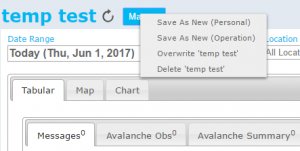Difference between revisions of "Modifying an existing InfoEx report template"
Jump to navigation
Jump to search
m (→Related documents) |
|||
| Line 1: | Line 1: | ||
__NOTOC__ | __NOTOC__ | ||
| − | {{Requirements|UserLevel= | + | {{Requirements|UserLevel=Operation Administrator and higher|Connectivity=Online only}} |
| − | This page describes how an existing customized report template can be modified. | + | This page describes how an existing customized InfoEx report template can be modified. |
==Background== | ==Background== | ||
| − | + | The InfoEx system allows users to fully customized InfoEx reports with respect to content ([[Specifying the date or date range of an InfoEx report|dates]], [[Restricting the locations included in an InfoEx report|locations]], [[Specifying the tables to be included in an InfoEx report|observation types]], [[Adding or removing columns of individual tables in an InfoEx report|observation parameters]], and [[Applying filters to individual tables in an InfoEx report|observation characteristics]]) and layout ([[Specifying the order of the tables in an InfoEx report|order of tables]], [[Grouping of observations within tables|grouping of observations]], [[Sorting individual tables in an InfoEx report|sorting of observations]], [[Single page view versus individual tabs for tables|report format]]). | |
| − | + | Alterations to an existing report template can be preserved as a new report template without altering the existing template, or you can overwrite existing report templates with modified ones. | |
| − | |||
| − | Alterations to | ||
| − | |||
| − | |||
==Step-by-Step Description== | ==Step-by-Step Description== | ||
| Line 17: | Line 13: | ||
|- | |- | ||
|class="StepNum" | 1. | |class="StepNum" | 1. | ||
| − | | | + | |To modify an existing report template, load the template by selecting it from the REPORTS menu and modify its content and layout as you wish. |
|- | |- | ||
|class="StepNum" | 2. | |class="StepNum" | 2. | ||
| − | | | + | |[[File:SaveAsNewReport.png|300px|thumb|right|Fig.1: Saving the modifications of an existing report template]]To preserve the style of the modified reprot template, clikc on the {{ButtonBlue|Manage}} button to the right of the name label of the original report template ''''Save Current View'''' (fig. 2). |
|- | |- | ||
|class="StepNum" | 3. | |class="StepNum" | 3. | ||
| − | |||
| − | |||
| − | |||
|Select ''''Save as New'''' if you want to preserve both the old and new report templates. Select ''''Overwrite'''' if you want to apply your modifications to the current report template. | |Select ''''Save as New'''' if you want to preserve both the old and new report templates. Select ''''Overwrite'''' if you want to apply your modifications to the current report template. | ||
|- | |- | ||
| Line 31: | Line 24: | ||
==Related documents== | ==Related documents== | ||
| + | {{PagesInfoExReport}} | ||
==Functionality tested by== | ==Functionality tested by== | ||
| − | * | + | * Jan 1, 2014: Pascal Haegeli |
| − | + | [[Category:Super User]][[Category:Operation Administrator]][[Category:Reports]][[Category:Version 3.4.0]] | |
| − | [[Category:Super User]][[Category:Operation Administrator]] | ||
| − | [[Category:Reports | ||
| − | |||
Revision as of 19:00, 1 January 2014
| REQUIREMENTS | |
| Permission | Operation Administrator and higher |
| Connectivity | Online only |
This page describes how an existing customized InfoEx report template can be modified.
Background
The InfoEx system allows users to fully customized InfoEx reports with respect to content (dates, locations, observation types, observation parameters, and observation characteristics) and layout (order of tables, grouping of observations, sorting of observations, report format).
Alterations to an existing report template can be preserved as a new report template without altering the existing template, or you can overwrite existing report templates with modified ones.
Step-by-Step Description
| 1. | To modify an existing report template, load the template by selecting it from the REPORTS menu and modify its content and layout as you wish. |
| 2. | To preserve the style of the modified reprot template, clikc on the Manage button to the right of the name label of the original report template 'Save Current View' (fig. 2). |
| 3. | Select 'Save as New' if you want to preserve both the old and new report templates. Select 'Overwrite' if you want to apply your modifications to the current report template. |
Related documents
Customizing reports
[1] Click to watch a help video
[2] Click to watch a help video
- Content
- Specifying the date or date range of an InfoEx report
- Restricting the locations included in an InfoEx report
- Specifying the tables to be included in an InfoEx report
- Adding or removing columns of individual tables in an InfoEx report
- Applying filters to individual tables in an InfoEx report
- Including or excluding proprietary information in an InfoEx report
- Layout
Managing report templates
- Saving a report as an InfoEx report template
- Modifying an existing InfoEx report template
- Deleting an existing InfoEx report template
- Signing up for the daily InfoEx report emails
Viewing report templates
Map Layers
- Operation overview
- Avalanche observations
- Avalanche hazard
- Snow Profiles
- Field summary
- Weather observations
- Time slider (used for all map layers)
- Additional external information sources
Charts
Functionality tested by
- Jan 1, 2014: Pascal Haegeli
